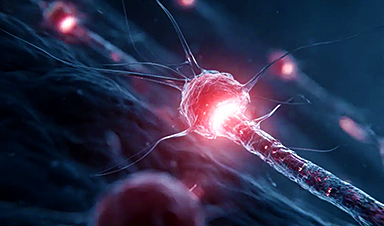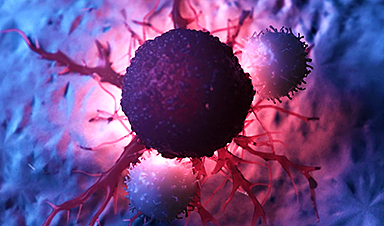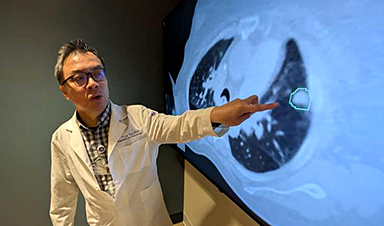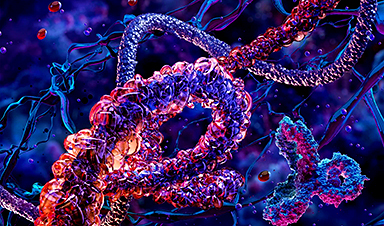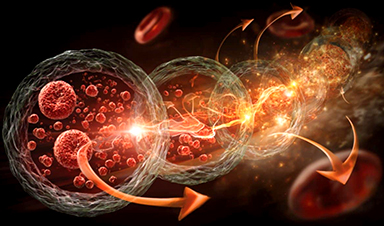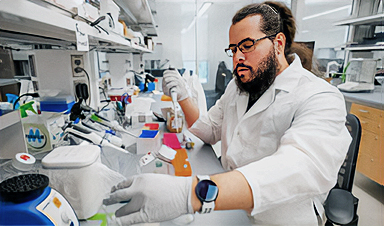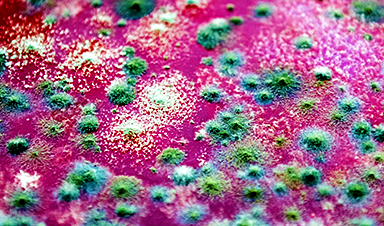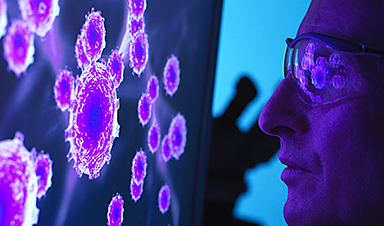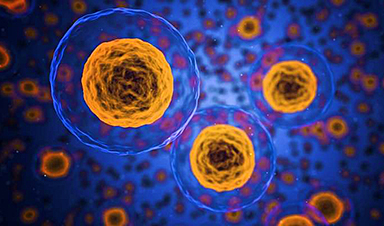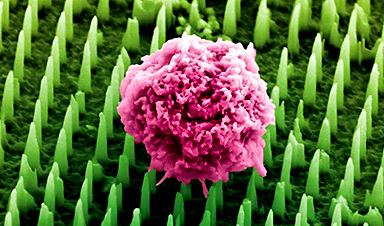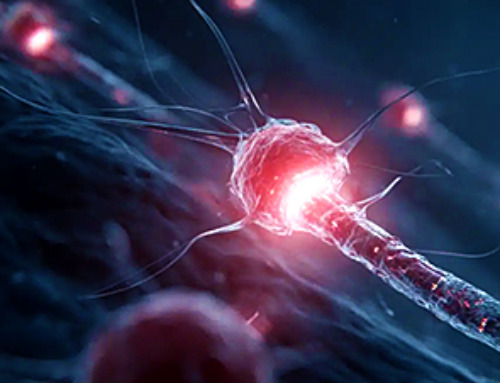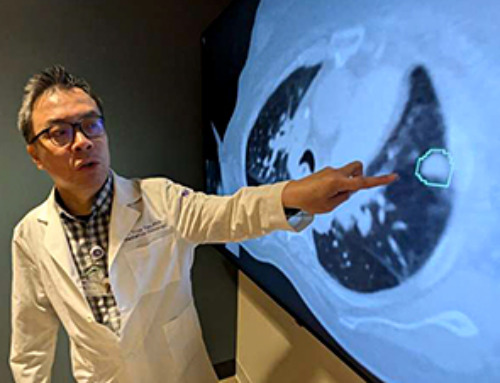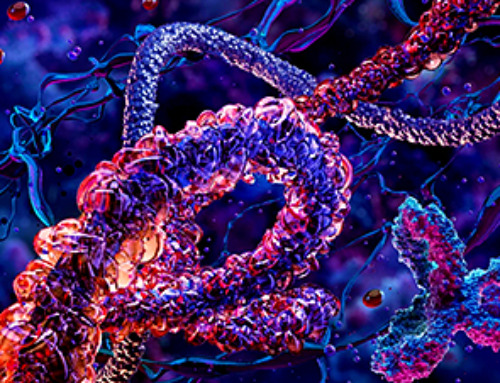| Nanoparticles are everywhere. They are in our body as protein aggregates, lipid vesicles, or viruses. They are in our drinking water in the form of impurities. They are in the air we breath as pollutants. At the same time, many drugs are based on the delivery of nanoparticles, including the vaccines we have been recently given. | |
| Keeping with the pandemics, quick tests used for the detection the SARS-Cov-2 are based on nanoparticles too. The red line, which we monitor day by day, contains myriads of gold nanoparticles coated with antibodies against proteins that report infection. | |
| Technically, one calls something a nanoparticle when its size (diameter) is smaller than one micrometer (one thousandth of a millimeter). Objects of the order of one micrometer can still be measured in a normal microscope, but particles that are much smaller, say smaller than 0.2 micrometers, become exceedingly difficult to measure or characterize. Interestingly, this is also the size range of viruses, which can become as small as 0.02 micrometers. |
| Over the years, scientists and engineers have devised a number of instruments for characterizing nanoparticles. Ideally, one wants to measure their concentration, assess their size and size distribution, and determine their substance. A high-end example is an electron microscope. | |
| But this technology has many shortcomings. It is very bulky and expensive, and the studies take too long because samples have to be carefully prepared and be put into vacuum. And even then, it remains difficult to determine the substance of the particles one sees in an electron microscope. | |
| A quick, reliable, light and portable device that can be used in the doctor’s office or in the field would have a huge impact. A few optical instruments on the market offer such solutions, but their resolution and precision have been insufficient for examining smaller nanoparticles, e.g., much smaller than 0.1 micrometer (or otherwise said 100 nm). | |
| A group of researchers at the Max Planck Institute for the Science of Light and Max-Planck-Zentrum für Physik und Medizin have now invented a new device that offers a big leap in the characterization of nanoparticles. The method is called iNTA, short for Interferometric Nanoparticle Tracking Analysis. | |
| Their results are reported in the May issue of Nature Methods (“Precision size and refractive index analysis of weakly scattering nanoparticles in polydispersions”). |
| The method is based on the interferometric detection of the light scattered by individual nanoparticles that wander around in a liquid. In such a medium, thermal energy perpetually moves particles in random directions. It turns out that the space that a particle explores in a given time correlates with its size. In other words, small particles move “faster” and cover a bigger volume than large particles. | |
| The equation that describes this phenomenon – the Stokes-Einstein relation – dates back to the beginning of the last century and since then has found use in many applications. In a nutshell, if one could follow a nanoparticle and collect statistics about its jittery trajectory, one could deduce its size. So, the challenge is to record very fast movies of tiny particles wizzing by. | |
| Scientists at MPL have developed a special microscopy method over the past two decades, known as interferometric scattering (iSCAT) microscopy. This technique is extremely sensitive in detecting nanoparticles. By applying iSCAT to the problem of diffusing nanoparticles, the MPL group realized that they can outperform the existing instruments on the market. The new technology has a particular edge in deciphering mixtures of nanoparticles with different sizes and different materials. | |
| The applications of the new method are manifold. A particularly exciting line of applications concerns nano-sized vehicles that are secreted from cells, the so-called extracellular vesicles. These are made of a lipid shell, much like a nano soap bubble. But the shell and the inner liquid also contain proteins, which tell us about the origin of the vesicles, i.e. from which organ or cellular process. When the protein amount and/or the vesicle size deviate from the normal range, it could be that the person is ill. Therefore, it is very important to find ways to characterize extracellular vesicles. | |
| The researchers at the MPL and MPZPM are now working on developing a bench-top system to enable scientists worldwide to benefit from the advantages of iNTA. |
News
Drug-Coated Neural Implants Reduce Immune Rejection
Summary: A new study shows that coating neural prosthetic implants with the anti-inflammatory drug dexamethasone helps reduce the body’s immune response and scar tissue formation. This strategy enhances the long-term performance and stability of electrodes [...]
Scientists discover cancer-fighting bacteria that ‘soak up’ forever chemicals in the body
A family of healthy bacteria may help 'soak up' toxic forever chemicals in the body, warding off their cancerous effects. Forever chemicals, also known as PFAS (per- and polyfluoroalkyl substances), are toxic chemicals that [...]
Johns Hopkins Researchers Uncover a New Way To Kill Cancer Cells
A new study reveals that blocking ribosomal RNA production rewires cancer cell behavior and could help treat genetically unstable tumors. Researchers at the Johns Hopkins Kimmel Cancer Center and the Department of Radiation Oncology and Molecular [...]
AI matches doctors in mapping lung tumors for radiation therapy
In radiation therapy, precision can save lives. Oncologists must carefully map the size and location of a tumor before delivering high-dose radiation to destroy cancer cells while sparing healthy tissue. But this process, called [...]
Scientists Finally “See” Key Protein That Controls Inflammation
Researchers used advanced microscopy to uncover important protein structures. For the first time, two important protein structures in the human body are being visualized, thanks in part to cutting-edge technology at the University of [...]
AI tool detects 9 types of dementia from a single brain scan
Mayo Clinic researchers have developed a new artificial intelligence (AI) tool that helps clinicians identify brain activity patterns linked to nine types of dementia, including Alzheimer's disease, using a single, widely available scan—a transformative [...]
Is plastic packaging putting more than just food on your plate?
New research reveals that common food packaging and utensils can shed microscopic plastics into our food, prompting urgent calls for stricter testing and updated regulations to protect public health. Beyond microplastics: The analysis intentionally [...]
Aging Spreads Through the Bloodstream
Summary: New research reveals that aging isn’t just a local cellular process—it can spread throughout the body via the bloodstream. A redox-sensitive protein called ReHMGB1, secreted by senescent cells, was found to trigger aging features [...]
AI and nanomedicine find rare biomarkers for prostrate cancer and atherosclerosis
Imagine a stadium packed with 75,000 fans, all wearing green and white jerseys—except one person in a solid green shirt. Finding that person would be tough. That's how hard it is for scientists to [...]
Are Pesticides Breeding the Next Pandemic? Experts Warn of Fungal Superbugs
Fungicides used in agriculture have been linked to an increase in resistance to antifungal drugs in both humans and animals. Fungal infections are on the rise, and two UC Davis infectious disease experts, Dr. George Thompson [...]
Scientists Crack the 500-Million-Year-Old Code That Controls Your Immune System
A collaborative team from Penn Medicine and Penn Engineering has uncovered the mathematical principles behind a 500-million-year-old protein network that determines whether foreign materials are recognized as friend or foe. How does your body [...]
Team discovers how tiny parts of cells stay organized, new insights for blocking cancer growth
A team of international researchers led by scientists at City of Hope provides the most thorough account yet of an elusive target for cancer treatment. Published in Science Advances, the study suggests a complex signaling [...]
Nanomaterials in Ophthalmology: A Review
Eye diseases are becoming more common. In 2020, over 250 million people had mild vision problems, and 295 million experienced moderate to severe ocular conditions. In response, researchers are turning to nanotechnology and nanomaterials—tools that are transforming [...]
Natural Plant Extract Removes up to 90% of Microplastics From Water
Researchers found that natural polymers derived from okra and fenugreek are highly effective at removing microplastics from water. The same sticky substances that make okra slimy and give fenugreek its gel-like texture could help [...]
Instant coffee may damage your eyes, genetic study finds
A new genetic study shows that just one extra cup of instant coffee a day could significantly increase your risk of developing dry AMD, shedding fresh light on how our daily beverage choices may [...]
Nanoneedle patch offers painless alternative to traditional cancer biopsies
A patch containing tens of millions of microscopic nanoneedles could soon replace traditional biopsies, scientists have found. The patch offers a painless and less invasive alternative for millions of patients worldwide who undergo biopsies [...]

